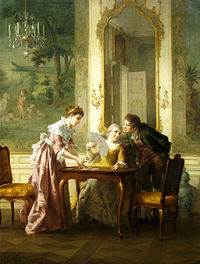You can help expand this article with text translated from the corresponding article in German. (July 2021) Click for important translation instructions.
|



Otto Wilhelm Eduard Erdmann (7 December 1834, Leipzig - 9 December 1905, Düsseldorf) was a German genre painter in the Rococo Revival style.
Biography
His father was the chemist, Otto Linné Erdmann. He began his artistic education at the Leipziger Akademie and later attended the Dresden Academy of Fine Arts, followed by the Academy of Fine Arts, Munich, where he studied with the genre painter, Ludwig von Hagn. In 1858, he settled in Düsseldorf, where he began to specialize in Rococo Revival paintings, largely set in a light-hearted court environment.
He was a member of the artists' association, "Malkasten", and sat on its board of directors for many years. He was also an amateur actor. In 1898, he was awarded the Order of the Red Eagle. In addition to his paintings, he created illustrations; notably for the inaugural edition of the Belgian journal, L'Illustration Européenne in 1870.
Gallery
-
 Saying Farewell
Saying Farewell
-
 Proposal, 1873
Proposal, 1873
-
 Le message, 1872
Le message, 1872
-
 Die Gartenlaube (The Garden Arbor)
Die Gartenlaube (The Garden Arbor)
-
 Marriage Proposal
Marriage Proposal
-
 I might soon be rich
I might soon be rich
-
 Die Gartenlaube
Die Gartenlaube
References
- Otto Linné Erdmann in: Professorenkatalog der Universität Leipzig. Herausgegeben vom Lehrstuhl für Neuere und Neueste Geschichte, Historisches Seminar der Universität Leipzig. Leipzig 2016.
- Adolf Rosenberg: Aus der Düsseldorfer Malerschule. Studien und Skizzen. Leipzig 1890, pg. 43.
- "Bestandsliste des Künstlervereins Malkasten (Stand 07/2005)". Archived from the original on 12 July 2018. Retrieved 12 April 2017.
- Personalnachrichten. In: Kunstchronik: Wochenschrift für Kunst und Kunstgewerbe, N.F. 9, 1898, Vol.32, pg.521 (Online)
Further reading
- Babette Marie Warncke: Rokoko-Mode. Rokokorezeption in der deutschen Malerei des 19. Jahrhunderts. Dissertation an der Albert-Ludwigs-Universität, Freiburg im Breisgau 1995, S. 50 ff. (Online)
- Erdmann, Otto. In: Friedrich von Boetticher: Malerwerke des neunzehnten Jahrhunderts. Beitrag zur Kunstgeschichte. Dresden 1891, Vol.1, pg.275
External links
This article about a German painter is a stub. You can help Misplaced Pages by expanding it. |